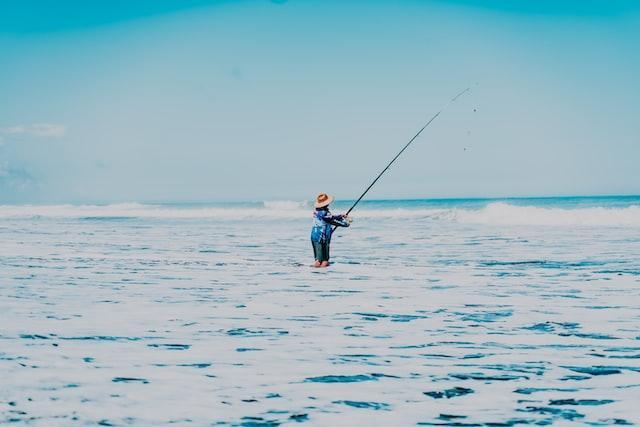Surf fishing is a great outdoor activity that promises lots of fun and memorable moments.
I mean, you spend a peaceful day on the beach, your body gets plenty of vitamin D, you stay active, and maybe you can bring some fish for dinner. As an angler, I believe that there is no better way to spend the day.
But is all this without risk? Can surf fishing be dangerous? Are there any hidden dangers and threats you should consider before heading to the beach?
Overall, surf fishing is a very safe activity. Accidents on the beach while holding a rod are extremely rare and shouldn’t worry you that much. However, it is important to be aware of all sources of hazards when surf fishing in order to minimize the risk of causing them.
In this article, we are going to list 6 accidents that can happen when surf fishing and all the measures to take in order to avoid them.
The most common accidents when surf fishing
1 – Hook injuries
Hooks are the most dangerous objects in fishing. They are sharp, small, and easily penetrate human flesh.
What’s worse is that once a barbed hook pierces you, it’s extremely difficult to pull it out without causing more damage to the skin.
In general, hook-related incidents require professional care in an emergency room. Unfortunately, some can cause irreversible damage, especially when they affect the eyes, face, or genitals.
So always be careful when working with hooks. Most accidents happen when anglers set up their rigs or unhook the fish they catch.
Also, never cast the line unless you are 100% sure no one is around you.
It should be noted here that circle hooks are less dangerous than J-shaped hooks. Since their points are heading inward, it is much more difficult to grab your hands while working with them.
Circle hooks also provide many other advantages to surf anglers, such as automatic hooksets, better bait retention, and they are more suitable for catch and release.
2 – Tackle snaps
Surf fishing often requires long casts in order to reach far areas with probably more rewards.
The problem with power casts is that they exert tremendous pressure on the line, increasing the risk of break-offs and hence putting the life of surrounding people at risk.
If your line breaks during a cast, the sinker and hook will fly in a random direction and may, as a result, hit someone on the beach, causing serious injury.
This usually happens when the pound test of the line cannot support the weight you cast.
This is where shock leaders come in handy. A shock leader is a strong line extension that you add to the end of the main line in order to absorb the massive stress you create when casting. As a rule of thumb, the shock leader’s pound test should be 10 times the ounces you throw.
For instance, if your casting weight is 5 oz, the shock leader should be at least 50 lb test. That’s the minimum to prevent snaps during casts.
Note that the best line material for shock leaders is monofilament because it’s stretchy and abrasion resistant.
Learn more about shock leaders and surf fishing.
3 – High swells
Surf fishing can be dangerous when the water is extremely choppy and rough.
The safest choice is to never be on the beach when the swell exceeds 5 feet.
Yes, 5 feet may seem like nothing, but it can, in no time, turn into something bigger that can sweep you off your soles while standing on the shoreline waiting for a bite.
Worth noting here that a choppy surf is usually rewarding to anglers because it creates more feeding opportunities for the fish and hence encourages them to approach the shore. However, extremely rough conditions are counterproductive as they disorient even the largest fish and force them to move deeper.
So there won’t be much to risk for your life for.
Wearing a wader and fishing knee-deep in the surf zone is also something to do after a lot of thought and consideration.
When the surf is calm and the swell is gentle, it can be very rewarding and provide you with a better reach to the strike zones. But in the wrong conditions, it can easily be life-threatening. So think twice and thrice before getting wet.
4 – Dangerous fish
Surf fishing introduces you to a wide range of fish species. Most are safe and harmless, but there are a few that can hurt you if you catch them.
For example, sharks, eel fish, bluefish, albacore tuna, and other toothy species should be handled with a lot of precaution when you land them. Bites from such sharp jaws can cause unbearable pain and severe bleeding.
Trying to unhook the fish with your bare hands is the number one cause of such accidents. A specialized plier is the best solution and completely mitigates the risk.
Other fish that can hurt you when surf fishing are those that are poisonous and secrete poisonous substances when they sting or bite.
Such incidents are extremely rare, but when they happen, they can be fatal. Pufferfish, lionfish, stonefish, and stingrays are among the species to watch out for here.
As a general rule, avoid touching fish you do not recognize. Cut the line a few inches above the hook and lift it from there. If you can’t find anyone to confirm it’s a safe catch, release it back. Don’t worry, fish can survive with a hook in their mouth 😉
5 – Sunburns
Another way that surf fishing can be dangerous is when you expose yourself to too much sun.
Too much sun exposure can lead to dehydration, sunburn, and intense headaches.
In addition, excessive sun heat increases exposure to UV rays and therefore may cause many health issues, such as skin aging, skin damage, wrinkles, some eye problems, and even skin cancer.
It is therefore very important to reduce your exposure to the sun when surf fishing.
The first thing I recommend here is to buy a hat and a parasol. The beach umbrella will keep you in the shade while waiting for bites, and the hat will protect your head when you step out of the shade to retrieve the line or check your gear.
Investing in sunscreen is also a smart thing to do. Buy something that is water-resistant and protects against UV rays.
Sunglasses are also very vital when surf fishing.
Similarly, the main thing to check here is UV protection.
Also, make sure the sunglasses you choose are scratch-resistant. This is why it is better to opt for glass lenses and not plastic.
Generally, green/blue lenses are the most suitable for beach fishing. These colors provide notable contrast and allow better visibility through the water, especially on sunny days.
Finally, remember to drink plenty of water throughout the day. Other juices and drinks can also be helpful, but water should be your primary source of hydration.
6 – Abrasive lines
One of the most common injuries in surf fishing is when anglers accidentally cut their fingers with the line.
This usually happens during casts when the index finger releases the line to let the sinker fly through the air.
This is why it is highly recommended to wear a casting glove(*) when surf fishing as it protects your index finger from abrasive lines.
Another cause of injuries when surfcasting is when you try to pull the line with your bare hands, either to get out of a snag or in the middle of a fight with a fish.
Note that braided lines are more likely to cause such incidents than monofilament. Braid is much thinner than monofilament and can therefore penetrate human flesh very easily.
Learn more about the comparison between braid and monofilament.
Last world
Overall, surf fishing is not a dangerous activity and you shouldn’t worry too much when you’re packing your gear or heading to the beach.
However, it is very important to keep in mind all the surf-related hazards and incidents in order to stay aware and avoid unsafe practices. This is the best way to avoid any unfortunate outcome and return home safe and sound.
Worth noting here that surf fishing is more dangerous during the night. Low light conditions expose you to more dangers and therefore require more attention and precautions.
A friend may also be helpful. Surf fishing alone is usually fine, but it’s good to have someone by your side when the going gets tough.
Also, it’s always good to have a first aid kit when surf fishing. This is rarely a recommended item for surf fishing, but it can save your life (or that of others) one day.
Happy and safe fishing!
Some recommended surf fishing gear(*)
Note (*): If you make a purchase through links from this website, we may get a small share of the sale from Amazon or other similar affiliate programs.
Surf Fishing Survey
Help us provide you with better content by answering simple questions about your surf fishing experience and knowledge.
We will put the collected responses together and turn them into valuable information that will help you catch more fish from shore 😉
Note: No personal information will be collected with your answer.


